China Insight
Less Education, More Babies? Discussions Surrounding China’s Falling Birth Rate
Another year, another drop in birth rates: according to the latest statistics, China’s 2022 saw more deaths than births.
Published
2 years agoon
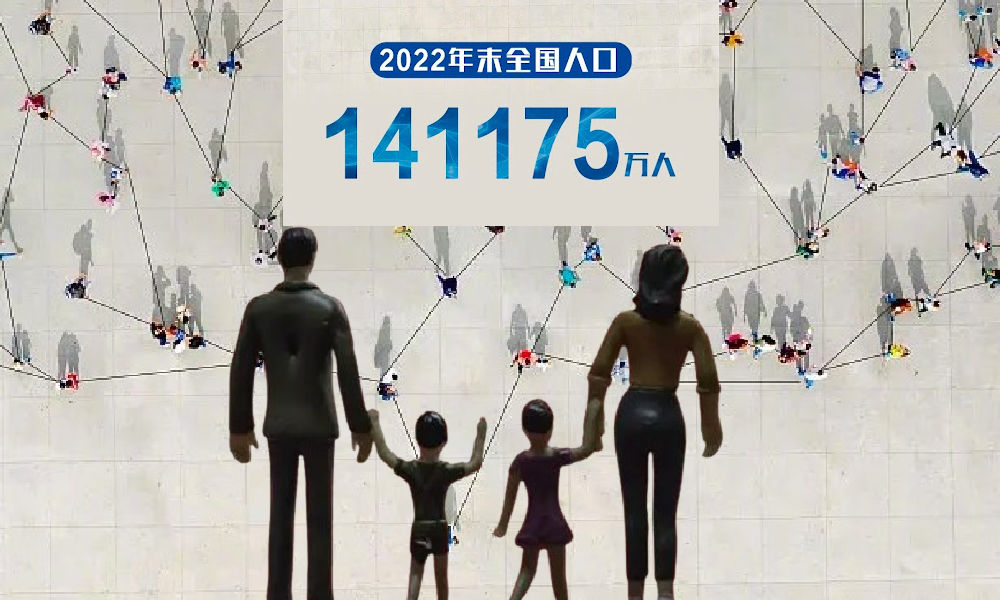
China’s falling birth rates have been a topic of discussion for years. With the latest statistics marking another record low in birth rates, Chinese experts look for ways to motivate couples to have (more) children at an earlier age.
Official yearbook data, released by China’s National Bureau of Statistics (国家统计局) on Jan. 17, 2023, shows that the total Chinese mainland population was 1.4118 billion by late 2022. Last year, 9.56 million people were born, while 10.41 million people died. The population in 2022 fell by 850,000 from 2021.
As reported by The New York Times, according to the latest data, 2022 was not just the first time deaths outnumbered births in China since the Great Leap Forward in 1960s, it was also one of the worst performance years for the Chinese economy since 1976.
China’s dropping birth rates have been a topic of discussion for years. The annual statistics that were published three years ago, in January 2020, showed that China’s birth rate in 2019 had fallen to its lowest since the founding of the People’s Republic of China. In that year, the birth rate was 10.48 per thousand, and 14.65 million babies were born in mainland China.
The data from later years showed that just 12 million babies were born in 2020 (8.5 births per thousand) and that only 10.6 million babies were born in 2021 – a rate of 7.52 births per thousand. The latest number is another record low.
Over recent years, various trends in Chinese (online) media have highlighted the social issues behind China’s dropping marriage and birth rates. The rising costs of living and the fact that Chinese younger generations “prefer to marry late,” are often mentioned as an explanation for China’s decline in marriage rates and the interrelated lowering birth rates.
But China’s so-called ‘leftover’ single men have also been pointed out as a “crisis,” with China having millions of more men than women of marriageable age – partly a consequence of the one-child policy combined with a traditional preference for baby boys.
For years, China’s ‘leftover women’ were also mentioned as a reason for the country’s declining marriage rates; China’s well-educated, career-oriented, urban single women were singled out for making it harder for China’s unmarried men to find a wife because of their ‘choice’ to postpone marriage and family life. This increased the pressure on China’s single women to get married, including facing an associated social stigma, which has become a recurring topic of debate on Chinese social media.
Chinese couples are allowed to have two children since 2015, three children since 2021, and it was later widely reported that parents with more than three children would also no longer receive fines according to a draft law amendment.
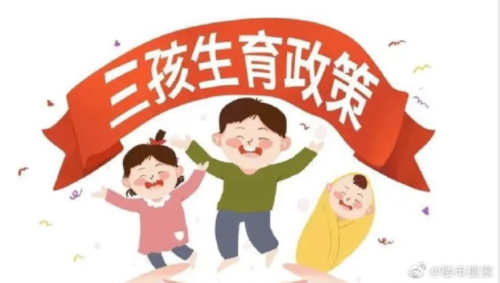
Celebrating the ‘three child policy’ (image via Weibo.com).
But the new regulations have not had the desired effect, with many couples simply not wanting a second child or being unable to afford it. The pandemic and zero Covid policy also haven’t exactly helped to boost China’s birth rates.
On social media, official media put out the two hashtags “9.56 Million People born in China in 2022” and “In 2022, China’s Population Decreased by 850,000 people” (#2022中国全年出生人口956万人#, #2022年中国人口减少85万人#). Among commenters, the latest data have led to various discussions.
Some are about the costs of living:
- “There’s so much to consider if you want to have a child, the costs are just too high, and I wouldn’t be able to support it.”
Others are about increasing social pressure:
- “These days there’s too much pressure on men to get married, they’re not confident and at ease anymore.”
And then there are those who see no problem in a population drop:
- “It’s only natural for the population to decline, how can you expect it to be like the old days when people would have five or six kids; the people like my grandma in my hometown all come from families with at least four kids.”
- “This country of 1,5 billion people is constantly worried about going extinct, people are crazy!”
- “The Information Age doesn’t need so many people anyway.”
HOW TO BOOST BIRTH RATES?
But while netizens’ opinions on the matter vary, experts, politicians, and media outlets focus on the topic of how China’s birth rates can be boosted.
Various places across China have already announced policies to encourage families to raise more than one child, including prolonged maternity leave, increased maternity allowances, and support for home purchases.
One hashtag that was popular on Weibo this week was about a statement made by the billionaire businessman Zong Qinghou (宗庆后), CEO of leading beverage company Wahaha Group (哇哈哈).
Zong is a proponent of offering affordable housing to young people. In a video that has since gone viral – and which was a segment from a CCTV interview, – Zong talks about his low-cost housing project and also called on China’s young people to find a partner, get married earlier and have children sooner to “contribute” to the country’s birth rates (#宗庆后希望年轻人早点结婚生娃#).
The hashtag triggered many replies. Most of them criticized Zong’s remarks, and many commenters expressed that they did not like being told to marry and have kids. Some also remarked how Zong’s own forty-something daughter allegedly is not married herself.
It is not the first time for an opinion leader or expert to frame marriage and childbirth as a “contribution” to the country. In 2015, the Chinese scholar Yang Zao (杨早) wrote an essay in which he explained China’s falling birth rates as “a clash between individualist and collectivist values.” At the time, he wrote: “For the country, for society, for parents, can’t you let go a bit of personal happiness? After all, isn’t marriage key to solving China’s present-day problems?”
Another hashtag that went viral this week is “Could Shortening Education Time Increase Birth Rates?” (#缩短教育时间能提高生育率吗#).
The topic relates to an article published by Zhejiang News on Jan. 16, 2023, about China’s Education and Population Report (中国教育和人口报告). In this report, James Jianzhang Liang (梁建章, a demographer who is better known as the Ctrip CEO) and other authors suggest that shortening the duration of education might help boost the country’s birth rates. The authors suggest that the middle and elementary education time could be cut down by two years by eliminating the Senior High School Entrance Examination (Zhongkao 中考).
There are two ways in which this idea might benefit China’s birth rates. On the one hand, the authors argue, China’s highly competitive education system puts a lot of pressure on children and financial strain on their parents, who struggle to invest as much time and money into their children’s education as they can. The pressure is real: the exam results during the last year of junior high school are of crucial importance regarding admission to the preferred senior high school, which also profoundly influences education after high school and students’ future careers. So the reasoning is that couples are more likely to have children if the financial burdens on parents are alleviated.
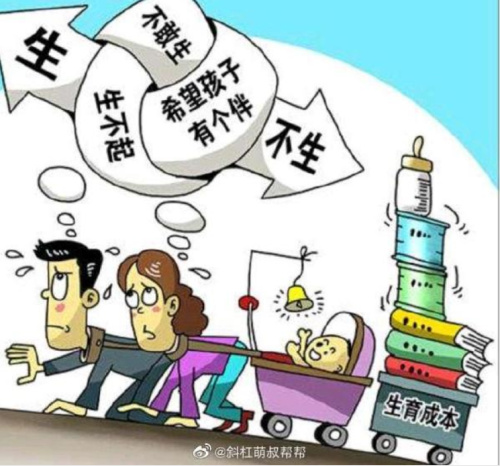
Should we have kids or not? Cartoon posted on Weibo.com.
On the other hand, the authors argue that when people finish school two years earlier, this will give them more time to start their life after graduation, making it more likely for women to have children at an earlier age.
One post about this topic, in which netizens were asked how they felt about the idea, received over 225,000 likes and nearly 13,000 comments.
A typical reply suggested that all these ‘experts’ should have more children themselves, reiterating a widespread criticism of opinion makers and experts who often do not practice what they preach.
Others expressed that they did not think that China’s lower birth rates were related to education, while others felt that a shortened education time would be a step back for China.
Some also criticized Zhejiang News. The media outlet itself indicated that the idea of shortening school years to boost fertility rates was like treating people as “tools.” But some commenters said: “The sad thing is not that people are treated as tools, the sad thing is that it took you this long to realize it.”
There are more Weibo bloggers and commenters suggesting that people paid a heavy price for the One Child policy that was implemented between 1980-2015, and that its effects will have a significant impact on society for a long time to come. After decades of only allowing couples to have one child, the shift to now introducing policies to encourage people to have more children is a strange reality.
One popular blogger (@峰哥亡命天涯) posted a photo that showed an old One Child Policy slogan on a building [少生优生,幸福一生 ‘Have fewer but healthier babies and a happier life‘], and he wrote: “The effects of family planning have contributed to contemporary times and bring benefits for future centuries!”

Another poster said they felt bad for the one-child generation born in the 1980s:
“I really feel sorry for those born in the 1980s. They’ve always dealt with problems in attending school from young to old, then when they were all grown up faced problems with the job [market], then the issue of marrying and the bride price, and most importantly the high price of housing and caring for the elderly – the 1980s generation is carrying the burden. Those born in the 1970s can no longer have children, and those born after ’95 or 2000 are not giving birth. So we can only squeeze the post-1980s (..) Let them finally take a breather.”
By Manya Koetse
with contributions by Zilan Qian
Get the story behind the hashtag. Subscribe to What’s on Weibo here to receive our newsletter and get access to our latest articles:
Spotted a mistake or want to add something? Please let us know in comments below or email us. First-time commenters, please be patient – we will have to manually approve your comment before it appears.
©2023 Whatsonweibo. All rights reserved. Do not reproduce our content without permission – you can contact us at info@whatsonweibo.com.
Manya Koetse is the founder and editor-in-chief of whatsonweibo.com. She is a writer, public speaker, and researcher (Sinologist, MPhil) on social trends, digital developments, and new media in an ever-changing China, with a focus on Chinese society, pop culture, and gender issues. She shares her love for hotpot on hotpotambassador.com. Contact at manya@whatsonweibo.com, or follow on Twitter.
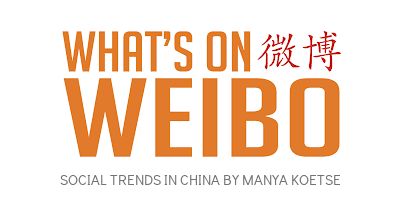
China Insight
The Tragic Story of “Fat Cat”: How a Chinese Gamer’s Suicide Went Viral
The story of ‘Fat Cat’ has become a hot topic in China, sparking widespread sympathy and discussions online.
Published
3 months agoon
May 9, 2024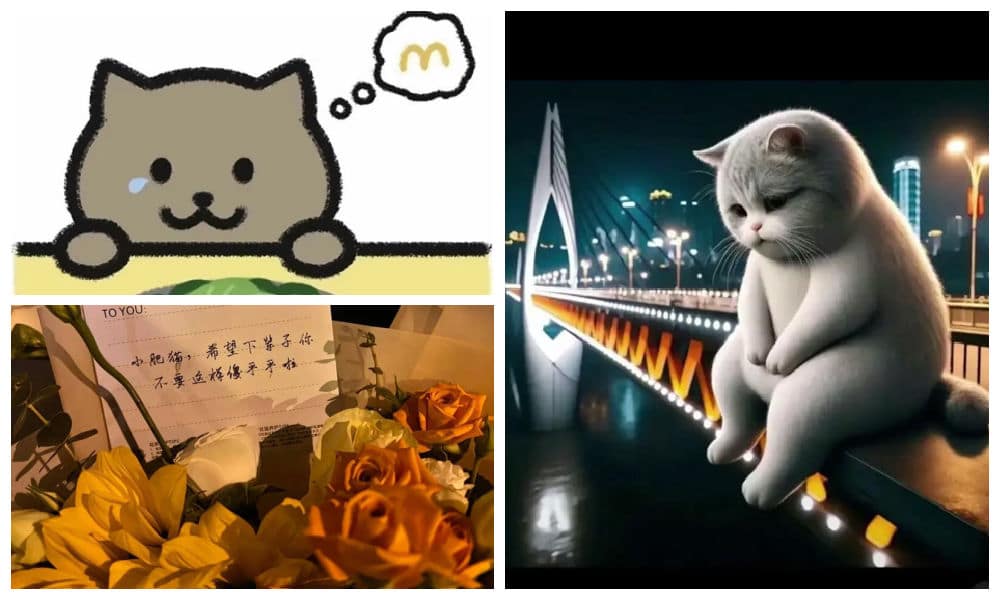
The tragic story behind the recent suicide of a 21-year-old Chinese gamer nicknamed ‘Fat Cat’ has become a major topic of discussion on Chinese social media, touching upon broader societal issues from unfair gender dynamics to businesses taking advantage of grieving internet users.
The story of a 21-year-old Chinese gamer from Hunan who committed suicide has gone completely viral on Weibo and beyond this week, generating many discussions.
In late April of this year, the young man nicknamed ‘Fat Cat’ (胖猫 Pàng Māo, literally fat or chubby cat), tragically ended his life by jumping into the river near the Chongqing Yangtze River Bridge (重庆长江大桥) following a breakup with his girlfriend. By now, the incident has come to be known as the “Fat Cat Jumping Into the River Incident” (胖猫跳江事件).
News of his suicide soon made its rounds on the internet, and some bloggers started looking into what was behind the story. The man’s sister also spoke out through online channels, and numerous chat records between the young man and his girlfriend emerged online.
One aspect of his story that gained traction in early May is the revelation that the man had invested all his resources into the relationship. Allegedly, he made significant financial sacrifices, giving his girlfriend over 510,000 RMB (approximately 71,000 USD) throughout their relationship, in a time frame of two years.
When his girlfriend ended the relationship, despite all of his efforts, he was devastated and took his own life.
The story was picked up by various Chinese media outlets, and prominent social and political commentator Hu Xijin also wrote a post about Fat Cat, stating the sad story had made him tear up.
As the news spread, it sparked a multitude of hashtags on Weibo, with thousands of netizens pouring out their thoughts and emotions in response to the story.
Playing Games for Love
The main part of this story that is triggering online discussions is how ‘Fat Cat,’ a young man who possessed virtually nothing, managed to provide his girlfriend, who was six years older, with such a significant amount of money – and why he was willing to sacrifice so much in order to do so.
The young man reportedly was able to make money by playing video games, specifically by being a so-called ‘booster’ by playing with others and helping them get to a higher level in multiplayer online battle games.
According to his sister, he started working as a ‘professional’ video gamer as a means of generating money to satisfy his girlfriend, who allegedly always demanded more.
He registered a total of 36 accounts to receive orders to play online games, making 20 yuan per game (about $2.80). Because this consumed all of his time, he barely went out anymore and his social life was dead.
In order to save more money, he tried to keep his own expenses as low as possible, and would only get takeout food for himself for no more than 10 yuan ($1,4). His online avatar was an image of a cat saying “I don’t want to eat vegetables, I want to eat McDonald’s.”

The woman in question who he made so many sacrifices for is named Tan Zhu (谭竹), and she soon became the topic of public scrutiny. In one screenshot of a chat conversation between Tan and her boyfriend that leaked online, she claimed she needed money for various things. The two had agreed to get married later in this year.
Despite of this, she still broke up with him, driving him to jump off the bridge after transferring his remaining 66,000 RMB (9135 USD) to Tan Zhu.
As the story fermented online, Tan Zhu also shared her side of the story. She claimed that she had met ‘Fat Cat’ over two years ago through online gaming and had started a long distance relationship with him. They had actually only met up twice before he moved to Chongqing. She emphasized that financial gain was never a motivating factor in their relationship.
Tan additionally asserted that she had previously repaid 130,000 RMB (18,000 USD) to him and that they had reached a settlement agreement shortly before his tragic death.
Ordering Take-Out to Mourn Fat Cat
– “I hope you rest in peace.”
– “Little fat cat, I hope you’ll be less foolish in your next life.”
– “In your next life, love yourself first.”
These are just a few of the messages left by netizens on notes attached to takeout food deliveries near the Chongqing Yangtze River Bridge.

AI-generated image spread on Chinese social media in connection to the event.
As Fat Cat’s story stirred up significant online discussion, with many expressing sympathy for the young man who rarely indulged in spending on food and drinks, some internet users took the step of ordering McDonalds and other food delivery services to the bridge, where he tragically jumped from, in his honor.
This soon snowballed into more people ordering food and drinks to the bridge, resulting in a constant flow of delivery staff and a pile-up of take-out bags.

Delivery food on the bridge, photo via Weibo.
However, as the food delivery efforts picked up pace, it came to light that some of the deliveries ordered and paid for were either empty or contained something different; certain restaurants, aware of the collective effort to honor the young man, deliberately left the food boxes empty or substituted sodas or tea with tap water.

At least five restaurants were caught not delivering the actual orders. Chinese bubble tea shop ChaPanda was exposed for substituting water for milk tea in their cups. On May 3rd, ChaPanda responded that they had fired the responsible employee.
Another store, the Zhu Xiaoxiao Luosifen (朱小小螺蛳粉), responded on that they had temporarily closed the shop in question to deal with the issue. Chinese fast food chain NewYobo (牛约堡) also acknowledged that at least twenty orders they received were incomplete.
Fast food company Wallace (华莱士) responded to the controversy by stating they had dismissed the employees involved. Mixue Ice Cream & Tea (蜜雪冰城) issued an apology and temporarily closed one of their stores implicated in delivering empty orders.
In the midst of all the controversy, Fat Cat’s sister asked internet users to refrain from ordering take-out food as a means of mourning and honoring her brother.
Nevertheless, take-out food and flowers continued to accumulate near the bridge, prompting local authorities to think of ways of how to deal with this unique method of honoring the deceased gamer.
Gamer Boy Meets Girl
On Chinese social media, this story has also become a topic of debate in the context of gender dynamics and social inequality.
There are some male bloggers who are angry with Tan Zhu, suggesting her behaviour is an example of everything that’s supposedly “wrong” with Chinese women in this day and age.
Others place blame on Fat Cat for believing that he could buy love and maintain a relationship through financial means. This irked some feminist bloggers, who see it as a chauvinistic attitude towards women.
A main, recurring idea in these discussions is that young Chinese men such as Fat Cat, who are at the low end of the social ladder, are actually particularly vulnerable in a fiercely competitive society. Here, a gender imbalance and surplus of unmarried men make it easier for women to potentially exploit those desperate for companionship.
The story of Fat Cat brings back memories of ‘Mo Cha Official,’ a not-so-famous blogger who gained posthumous fame in 2021 when details of his unhappy life surfaced online.
Likewise, the tragic tale of WePhone founder Su Xiangmao (苏享茂) resurfaces. In 2017, the 37-year-old IT entrepreneur from Beijing took his own life, leaving behind a note alleging blackmail by his 29-year-old ex-wife, who demanded 10 million RMB (±1.5 million USD) (read story).
Another aspect of this viral story that is mentioned by netizens is how it gained so much attention during the Chinese May holidays, coinciding with the tragic news of the southern China highway collapse in Guangdong. That major incident resulted in the deaths of at least 48 people, and triggered questions over road safety and flawed construction designs. Some speculate that the prominence given to the Fat Cat story on trending topic lists may have been a deliberate attempt to divert attention away from this incident.
‘Fat Cat’ was cremated. His family stated their intention to take necessary legal steps to recover the money from his former girlfriend, but Tan Zhu reportedly already reached an agreement with the father and settled the case. Nevertheless, the case continues to generate discussions online, with some people wondering: “Is it over yet? Can we talk about something different now?”

Fat Cat images projected in Times Square
However, given that images of the ‘Fat Cat’ avatar have even appeared in Times Square in New York by now (Chinese internet users projected it on one of the big LED screens), it’s likely that this story will be remembered and talked about for some time to come.
UPDATE MAY 25
On May 20, local authorities issued a lengthy report to clarify the timeline of events and details surrounding the death of “Fat Cat,” which had attracted significant attention across China.
The report concluded that there was no fraud involved and that “Fat Cat” and his girlfriend were in a genuine relationship. Tan did not deceive “Fat Cat” for money; the transfers were voluntary. Furthermore, Tan returned most of the money to his parents.
The gamer’s sister is reportedly still being investigated for potentially infringing on Tan’s privacy by disclosing numerous private details to the public.
In the end, one thing is clear in this gamer’s tragic story, which is that there are no winners.
By Manya Koetse
– With contributions by Miranda Barnes and Ruixin Zhang
Independently reporting China trends for over a decade. Like what we do? Support us and get the story behind the hashtag by subscribing:
Spotted a mistake or want to add something? Please let us know in comments below or email us. First-time commenters, please be patient – we will have to manually approve your comment before it appears.
©2024 Whatsonweibo. All rights reserved. Do not reproduce our content without permission – you can contact us at info@whatsonweibo.com.
China Brands, Marketing & Consumers
A Brew of Controversy: Lu Xun and LELECHA’s ‘Smoky’ Oolong Tea
Chinese tea brand LELECHA faced backlash for using the iconic literary figure Lu Xun to promote their “Smoky Oolong” milk tea, sparking controversy over the exploitation of his legacy.
Published
3 months agoon
May 3, 2024
It seemed like such a good idea. For this year’s World Book Day, Chinese tea brand LELECHA (乐乐茶) put a spotlight on Lu Xun (鲁迅, 1881-1936), one of the most celebrated Chinese authors the 20th century and turned him into the the ‘brand ambassador’ of their special new “Smoky Oolong” (烟腔乌龙) milk tea.
LELECHA is a Chinese chain specializing in new-style tea beverages, including bubble tea and fruit tea. It debuted in Shanghai in 2016, and since then, it has expanded rapidly, opening dozens of new stores not only in Shanghai but also in other major cities across China.
Starting on April 23, not only did the LELECHA ‘Smoky Oolong” paper cups feature Lu Xun’s portrait, but also other promotional materials by LELECHA, such as menus and paper bags, accompanied by the slogan: “Old Smoky Oolong, New Youth” (“老烟腔,新青年”). The marketing campaign was a joint collaboration between LELECHA and publishing house Yilin Press.

Lu Xun featured on LELECHA products, image via Netease.
The slogan “Old Smoky Oolong, New Youth” is a play on the Chinese magazine ‘New Youth’ or ‘La Jeunesse’ (新青年), the influential literary magazine in which Lu’s famous short story, “Diary of a Madman,” was published in 1918.
The design of the tea featuring Lu Xun’s image, its colors, and painting style also pay homage to the era in which Lu Xun rose to prominence.
Lu Xun (pen name of Zhou Shuren) was a leading figure within China’s May Fourth Movement. The May Fourth Movement (1915-24) is also referred to as the Chinese Enlightenment or the Chinese Renaissance. It was the cultural revolution brought about by the political demonstrations on the fourth of May 1919 when citizens and students in Beijing paraded the streets to protest decisions made at the post-World War I Versailles Conference and called for the destruction of traditional culture[1].
In this historical context, Lu Xun emerged as a significant cultural figure, renowned for his critical and enlightened perspectives on Chinese society.
To this day, Lu Xun remains a highly respected figure. In the post-Mao era, some critics felt that Lu Xun was actually revered a bit too much, and called for efforts to ‘demystify’ him. In 1979, for example, writer Mao Dun called for a halt to the movement to turn Lu Xun into “a god-like figure”[2].
Perhaps LELECHA’s marketing team figured they could not go wrong by creating a milk tea product around China’s beloved Lu Xun. But for various reasons, the marketing campaign backfired, landing LELECHA in hot water. The topic went trending on Chinese social media, where many criticized the tea company.
Commodification of ‘Marxist’ Lu Xun
The first issue with LELECHA’s Lu Xun campaign is a legal one. It seems the tea chain used Lu Xun’s portrait without permission. Zhou Lingfei, Lu Xun’s great-grandson and president of the Lu Xun Cultural Foundation, quickly demanded an end to the unauthorized use of Lu Xun’s image on tea cups and other merchandise. He even hired a law firm to take legal action against the campaign.
Others noted that the image of Lu Xun that was used by LELECHA resembled a famous painting of Lu Xun by Yang Zhiguang (杨之光), potentially also infringing on Yang’s copyright.
But there are more reasons why people online are upset about the Lu Xun x LELECHA marketing campaign. One is how the use of the word “smoky” is seen as disrespectful towards Lu Xun. Lu Xun was known for his heavy smoking, which ultimately contributed to his early death.
It’s also ironic that Lu Xun, widely seen as a Marxist, is being used as a ‘brand ambassador’ for a commercial tea brand. This exploits Lu Xun’s image for profit, turning his legacy into a commodity with the ‘smoky oolong’ tea and related merchandise.
“Such blatant commercialization of Lu Xun, is there no bottom limit anymore?”, one Weibo user wrote. Another person commented: “If Lu Xun were still alive and knew he had become a tool for capitalists to make money, he’d probably scold you in an article. ”
On April 29, LELECHA finally issued an apology to Lu Xun’s relatives and the Lu Xun Cultural Foundation for neglecting the legal aspects of their marketing campaign. They claimed it was meant to promote reading among China’s youth. All Lu Xun materials have now been removed from LELECHA’s stores.

Statement by LELECHA.
On Chinese social media, where the hot tea became a hot potato, opinions on the issue are divided. While many netizens think it is unacceptable to infringe on Lu Xun’s portrait rights like that, there are others who appreciate the merchandise.
The LELECHA controversy is similar to another issue that went trending in late 2023, when the well-known Chinese tea chain HeyTea (喜茶) collaborated with the Jingdezhen Ceramics Museum to release a special ‘Buddha’s Happiness’ (佛喜) latte tea series adorned with Buddha images on the cups, along with other merchandise such as stickers and magnets. The series featured three customized “Buddha’s Happiness” cups modeled on the “Speechless Bodhisattva” (无语菩萨), which soon became popular among netizens.

The HeyTea Buddha latte series, including merchandise, was pulled from shelves just three days after its launch.
However, the ‘Buddha’s Happiness’ success came to an abrupt halt when the Ethnic and Religious Affairs Bureau of Shenzhen intervened, citing regulations that prohibit commercial promotion of religion. HeyTea wasted no time challenging the objections made by the Bureau and promptly removed the tea series and all related merchandise from its stores, just three days after its initial launch.
Following the Happy Buddha and Lu Xun milk tea controversies, Chinese tea brands are bound to be more careful in the future when it comes to their collaborative marketing campaigns and whether or not they’re crossing any boundaries.
Some people couldn’t care less if they don’t launch another campaign at all. One Weibo user wrote: “Every day there’s a new collaboration here, another one there, but I’d just prefer a simple cup of tea.”
By Manya Koetse
[1]Schoppa, Keith. 2000. The Columbia Guide to Modern Chinese History. New York: Columbia UP, 159.
[2]Zhong, Xueping. 2010. “Who Is Afraid Of Lu Xun? The Politics Of ‘Debates About Lu Xun’ (鲁迅论争lu Xun Lun Zheng) And The Question Of His Legacy In Post-Revolution China.” In Culture and Social Transformations in Reform Era China, 257–284, 262.
Independently reporting China trends for over a decade. Like what we do? Support us and get the story behind the hashtag by subscribing:
Spotted a mistake or want to add something? Please let us know in comments below or email us. First-time commenters, please be patient – we will have to manually approve your comment before it appears.
©2024 Whatsonweibo. All rights reserved. Do not reproduce our content without permission – you can contact us at info@whatsonweibo.com.
Subscribe

Weibo Watch: The Future is Here

“Bye Bye Biden”: Biden’s Many Nicknames in Chinese

Enjoying the ‘Sea’ in Beijing’s Ditan Park

A Triumph for “Comrade Trump”: Chinese Social Media Reactions to Trump Rally Shooting

Weibo Watch: Get Up, Stand Up

The Tragic Story of “Fat Cat”: How a Chinese Gamer’s Suicide Went Viral

“Old Bull Eating Young Grass”: 86-Year-Old Chinese Painter Fan Zeng Marries 36-Year-Old Xu Meng

A Brew of Controversy: Lu Xun and LELECHA’s ‘Smoky’ Oolong Tea

Singing Competition or Patriotic Fight? Hunan TV’s ‘Singer 2024’ Stirs Nationalistic Sentiments

Zara Dress Goes Viral in China for Resemblance to Haidilao Apron

Weibo Watch: The Battle for the Bottom Bed

About the “AI Chatbot Based on Xi Jinping” Story

China’s Intensified Social Media Propaganda: “Taiwan Must Return to Motherland”

Weibo Watch: Telling China’s Stories Wrong

Saying Goodbye to “Uncle Wang”: Wang Wenbin Becomes Chinese Ambassador to Cambodia
Get in touch
Would you like to become a contributor, or do you have any tips or suggestions? Get in touch here!
Popular Reads
-

 China Insight3 months ago
China Insight3 months agoThe Tragic Story of “Fat Cat”: How a Chinese Gamer’s Suicide Went Viral
-

 China Music4 months ago
China Music4 months agoThe Chinese Viral TikTok Song Explained (No, It’s Not About Samsung)
-

 China Digital10 months ago
China Digital10 months agoToo Sexy for Weibo? Online Discussions on the Concept of ‘Cābiān’
-

 China Arts & Entertainment12 months ago
China Arts & Entertainment12 months agoBehind 8 Billion Streams: Who is Dao Lang Cursing in the Chinese Hit Song ‘Luocha Kingdom’?
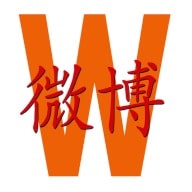






ZzZzz
January 20, 2023 at 2:18 am
Same story from all developed countries on repeat… Which countries have the highest birth rates? Answer: the undeveloped countries of absolute poverty of Africa. How to boost birth rates you ask? Answer: Send [developed] societies back to the stoneage.